The boat spluttered out of Elkhorn Slough, nosing cautiously into the open water of Monterey Bay. A chilling cloak of fog wrapped itself thickly around the little vessel. The sounds of Moss Landing harbor died in the gurgle of the spluttering exhaust.
Perhaps the fog would clear a mile or so off shore, and conditions for whale watching would improve. That is the thing with whale watching; the weather is always ready to play her tricks and determine the quality of the experience.
The previous mooring had been a whale fest. Clear skies and Humpbacks churning in great numbers. What a difference 24 hours makes on the Bay. Captain Kate shut off the engine and we rocked silently inside the clouds. Only the water bells jingling on the hull reminded us that we were still on the endless Pacific Ocean. Silence. Silence. Silence. Wheeeeeesh!!! A sudden burst of sound from the blind ocean and we spin towards the tyre-burst hiss. Wheeeeeesh!! Another Humpback whale breaks the surface, then another.
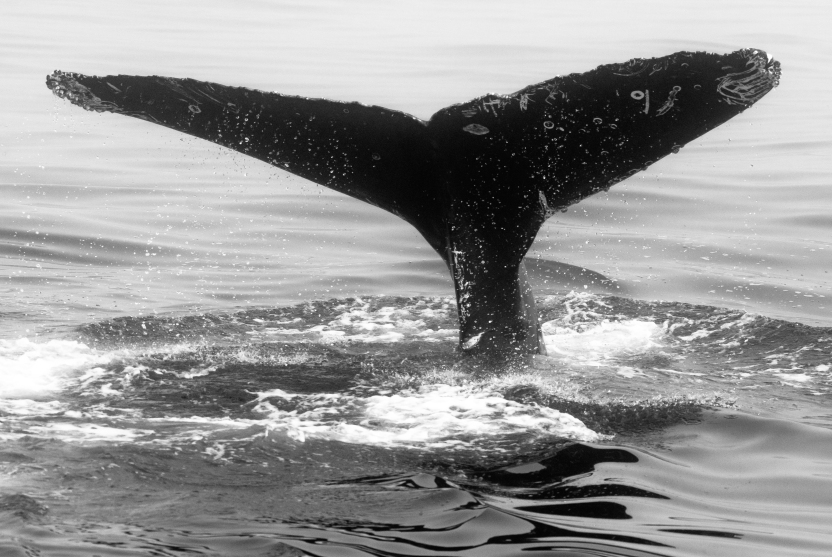
Three immense Humpback whales were laying alongside our boat, like a fleet of submarines. The sound of whales breathing was trapped within the shroud of fog. I breathed in the cool mist droplets mixed with the oil of anchovies and whale nasal mucus. Whale watching is a sublime experience. There is magic in those moments when you find yourself engulfed in a cloud of acrid whale breath. It is unforgettable.
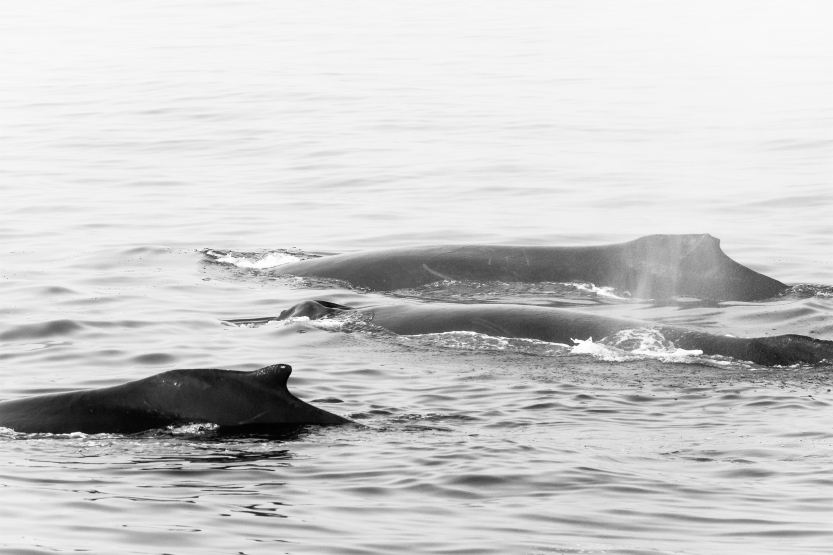
There are many places around the world where you can watch whales. I have set to sea from several countries to be in the company of whales. Australia, Sri Lanka and Canada have all provided unforgettable moments. But without doubt, if you want the best chance of experiencing whales, Monterey Bay is the place to go.
The city of Monterey is an extraordinary place for those of us who seek wildlife. California sea lions, Harbor seals, Sea otters, hummingbirds, Brown pelicans and it is just a short hop to visit the Monarch butterfly roost at Pacific Grove or the Elephant seals and California condors along the coast. Arguably, the jewels in the crown are the whales. Humpbacks, Grays, Orca, Fin, Blue and many dolphins.
I have spent several weekends watching the whales of the Bay. The drive from San Francisco International Airport can be as quick as 1 hr 40 minutes, but on a Friday afternoon it is often closer to 3 hours. I always take the coast road. There are few more exquisite drives than the Cabrillo Highway between Half Moon Bay and Santa Cruz, when the sun is drowning in the Pacific.
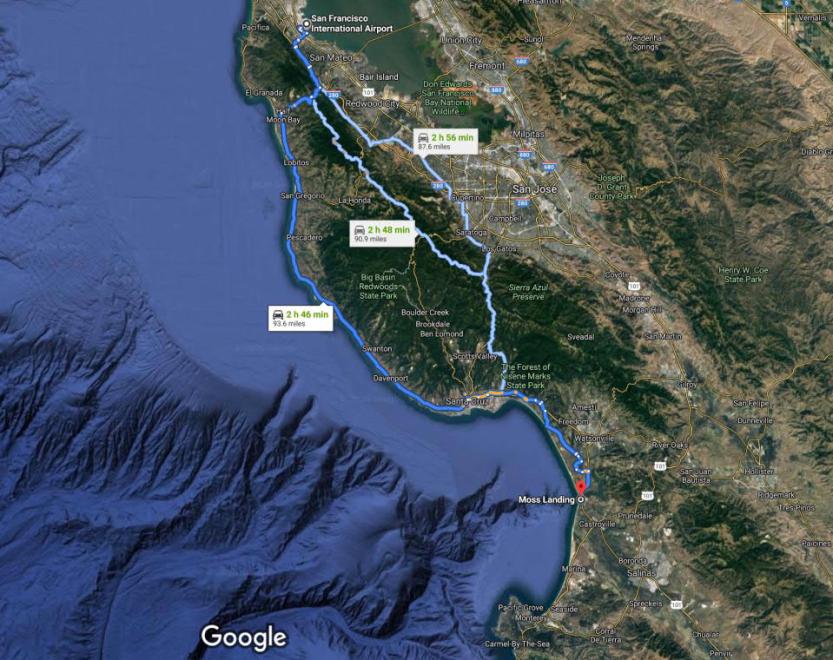
Whale watching can be done from Santa Cruz, Moss Landing or Monterey. My preference is to stay in Monterey, but to go out on to the Bay from Moss Landing.
Moss Landing sits at the centre of the Bay, and is the starting point for the Monterey Canyon; a submarine canyon that is a mile deep in places. Indeed the canyon is deeper than its famous landlocked cousin, the Grand Canyon. It is this submarine canyon that makes the Bay a sanctuary for whales. Up-swells of cold water bring a nutrient-rich soup that nourishes immense shoals of anchovies and krill. This is what the Humpbacks are here for, and they come in numbers.

Don’t just take my word for it. The National Geographic Venture was moored at the harbor mouth during my last visit. For those interested in marine life, as a hobby or as a profession, Monterey Bay is a must!
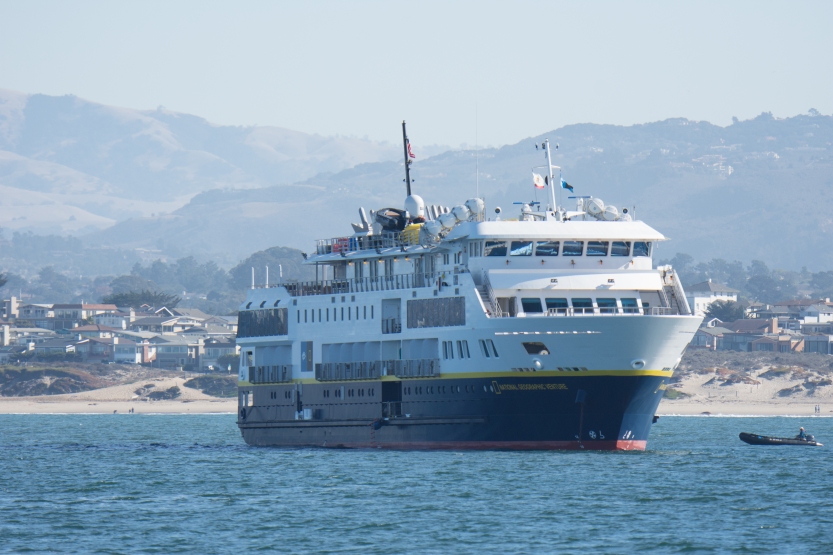
With the deep waters of the canyon opening up at the mouth of the Elkhorn Slough river, I start scanning the horizon for whales as soon as we leave the Slough. There are several ‘tells’ of the presence of a Humpback, the most common of which is the misty whale spout. That puff of white against the tungsten backdrop of the deep Bay waters.
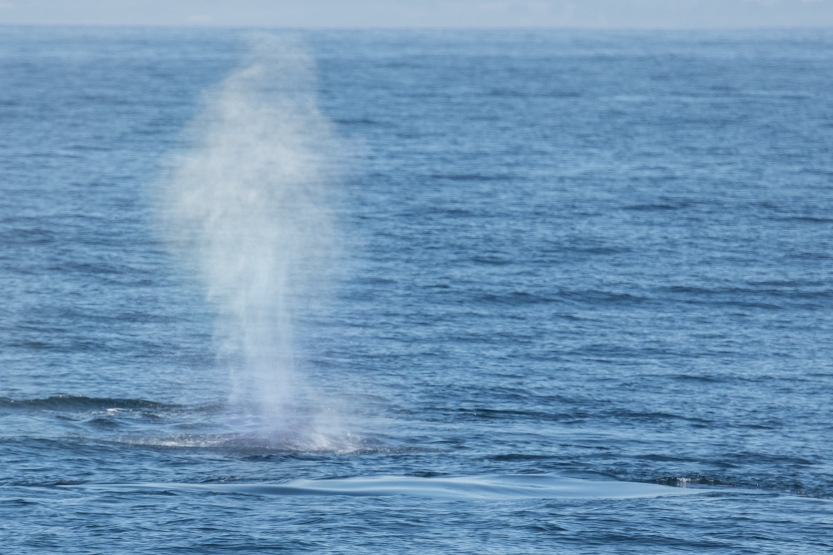
If the whale is close and the boat engines are silent then the woosh that bursts from the blowhole, gives away its presence in heart racing, bone jangling style.
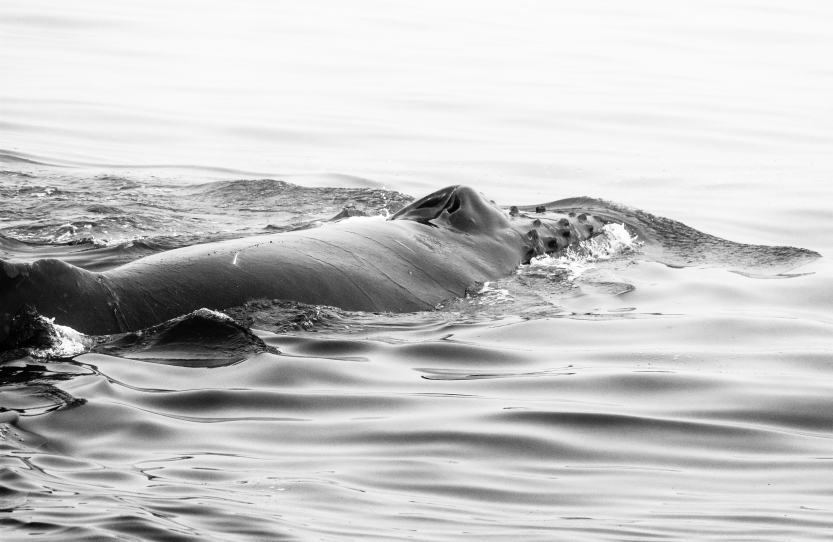
Unless the whale breaches, which is a rare event, it is one of the ‘tells’ that will give away its presence, rather than spotting the creature itself. I scanned the surface of the Bay for footprints. A whale footprint (see the photograph below) is a patch of water that takes on a glassy appearance. This is caused by the displacement of water from the whale tail as it dives, sending a vortex to the surface.
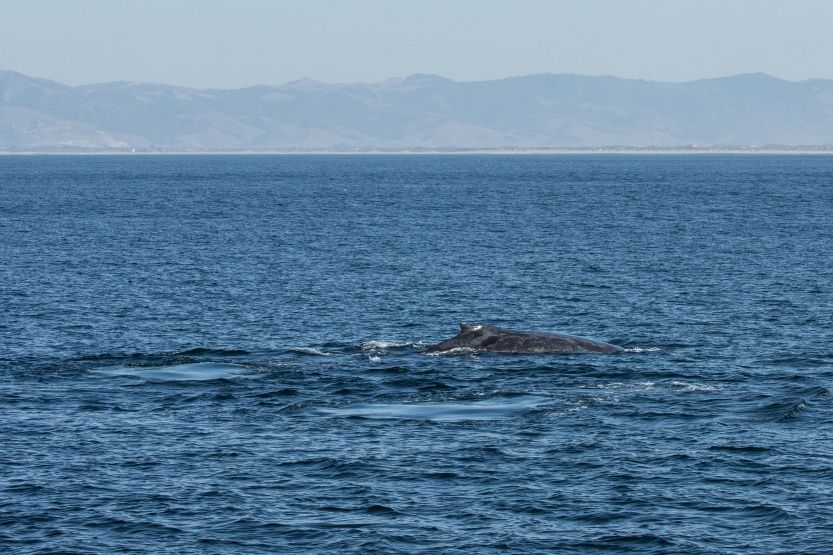
My final ‘tell’ is to look at what else is going on in the environment. A flock of gulls or a swirling raft of barking California sea lions might indicate a concentration of bait fish. Find the bait fish and you will find the whales.
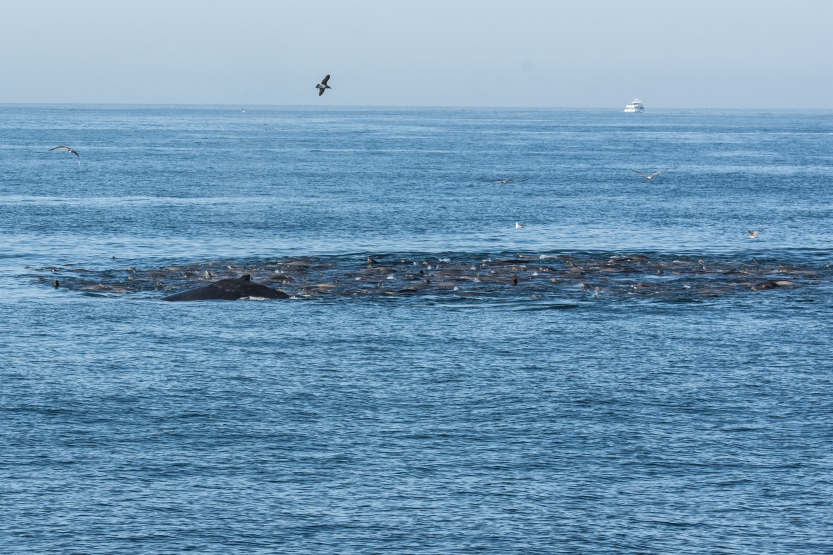
We approached a swirling swarm of sea lions, that were in state of frenzy, as a huge whale rolled through the raft. As we looked on, one of the most unusual behaviours that I have encountered in nature occurred. The Humpbacks and sea lions appeared to be hunting together. The sea lions would follow the whale along the surface until the whale dived. They would then follow the whale down to feed with it.
This behaviour was a photographers dream, because the sea lions can’t hold their breath for as long as the whale, so they would surface about 30 seconds before it. This provided me with the chance to be ready for the whale to burst the surface with an oily blast. It isn’t clear what role the actors in this scene play, but they appeared to be working together in an organised manner.

More whales entered the scene and birds gathered above. Some whales circled the feeding activity, keeping at a distance. It isn’t difficult to imagine that the outer whales were stopping the bait ball of fish or krill from dispersing, while the sea lions help keep the ball tight enough for the inner whales to gulp huge mouthfuls.
The Humpbacks whales are present in Monterey Bay year round, but in much fewer numbers in winter. The advice given to me was to go in summer for the Humpbacks, but I have found early to mid November to be the most fruitful time. It was one such November trip that gave me my most extraordinary whale experience.
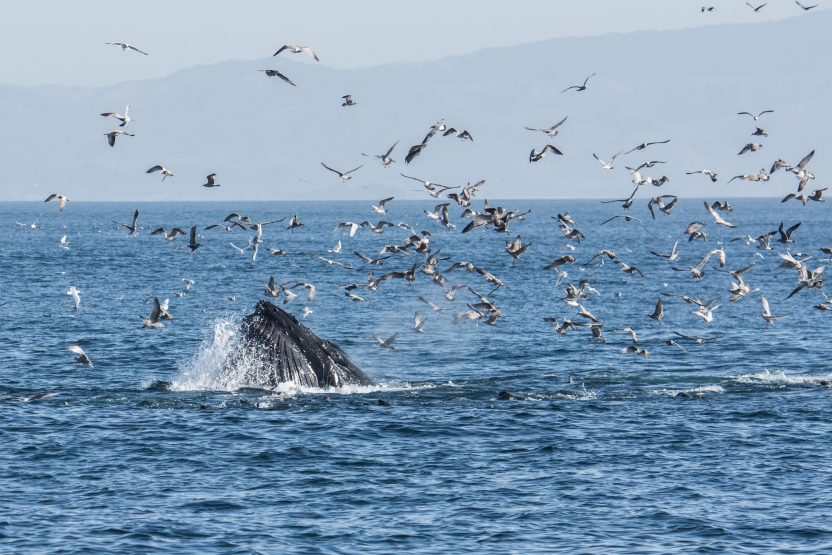
A swirl of gulls circled over a boiling ocean and as their clumsy hovering got lower and lower, I’m put in mind of Captain Ahab’s words as he waits for Moby Dick to show himself; “The birds, the birds, he rises!”. As Ahab’s famous Sperm whale rose, so did my mighty Humpback, it’s huge head clearing the water as it gulped at the fish soup.

As it’s enormous bulk slid back into the ocean, a second whale reared out of the water alongside it, spraying a mist of fish and scales into the air. Sea lions snatched at the silvery sparkles around the whale’s head and gulls grabbed at glitter drops in the air. I zoomed my lens to fill the frame. My breath froze in my throat as I saw a whale eye looking into me through my lens. The whale seemed to hang for a moment, studying those who study him, before sinking beneath the waves.
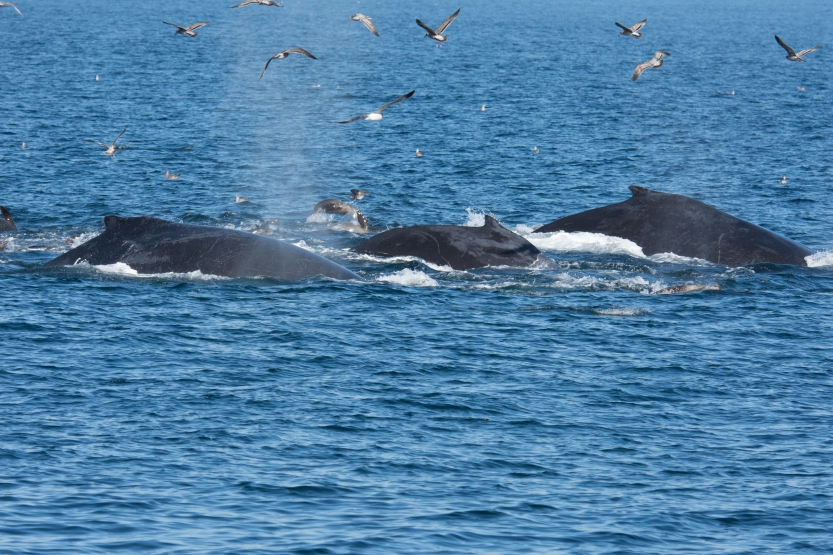
The call goes up as more whales surface. There were now eight, nine, or maybe ten whales surrounding us. There appeared to be two groups circling the scene, keeping the bait fish in the area. There were at least three whales under the bait ball, taking it in turns to lunge upwards, swallowing hundreds of thousands of fish at a time. I watched as a huge mouth opened and a stew of ocean and fish poured in. The whale’s throat pouch stretched in the boiling water and seemed to hold a whole ocean within the barnacled chin.

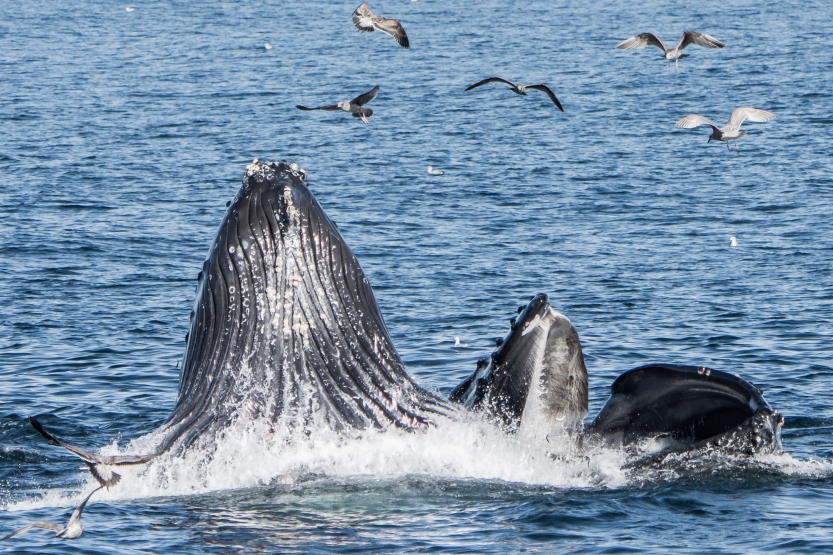
A second whale smashed through the surface at an angle and I saw bait fish being catapulted in all directions, sending the hovering gulls in to a frenzy.
Silence fell over us as the whales slid back into the deep. Some moments passed and with so much activity around us, I didn’t know where to look. Waiting, waiting, waiting. Suddenly the Pacific was torn asunder, as two enormous mouths burst from below, sending a scatter of bait fish, gulls and sea lions. I machine gunned my shutter release as the whales sank beneath the waves.
The scene fell silent again. The final lunge had either dispersed the bait ball or the whales had finally eaten every last mouthful. I looked down at my camera and a grin spread from ear to ear. I had the photographs that proved I wasn’t dreaming. It confirmed that this unique behaviour, that I had dreamed of seeing, had actually happened in front of me. I zoomed in on the photograph below. I could see the mouth, the tongue, the baleen hairs that filter food from the water and a closer look revealed anchovies trapped in the baleen. So that was what all the fuss was about; a tiny little fish that grows to less than an inch but powers the extraordinary marine life of Monterey Bay.

In Melville’s whaling classic Moby Dick, the prophet Elijah asks a crew member, referring to the whale torn Ahab “…did they tell you how the whale marked him inside as well as out?”. It is my contention that anyone who stands in the company of these lunge feeding leviathans will surely be forever marked on the inside by such a rapturous experience.
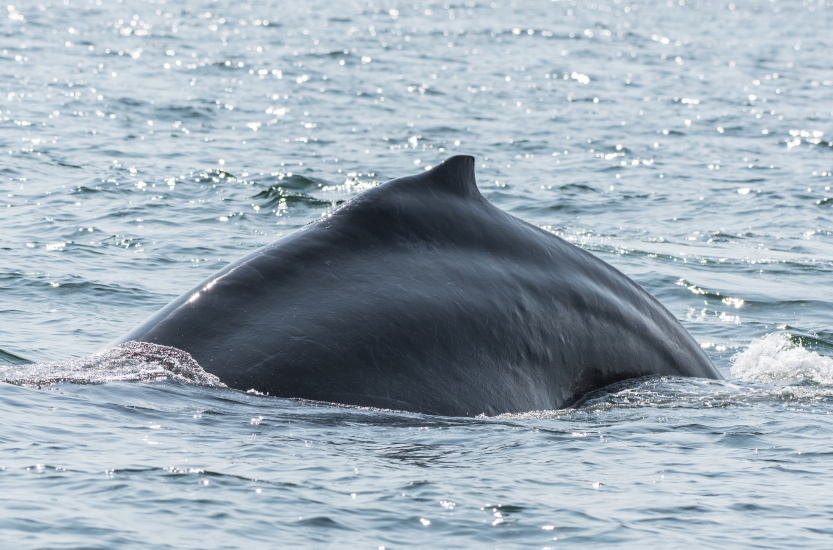
Not every time on the water has provided me with such a phenomenal experience, but every time on Monterey Bay has given me whales. Sometimes a lot, sometimes only a few, but I’ve never left disappointed.
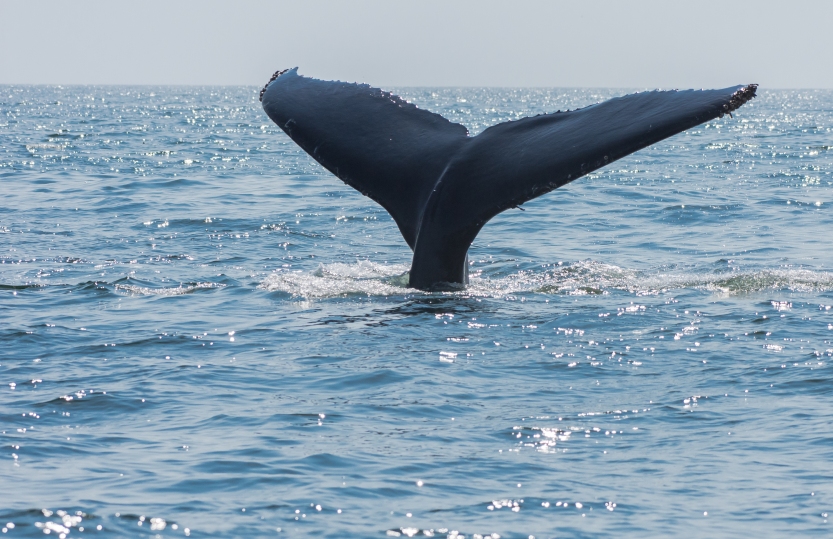
The rolling hump that gives the Humpback its name, or the sight of an immense tail sinking beneath the ocean are awe inspiring sights. The Bay throws up some wonderful photo opportunities, even on a slow whale day.

On days when the sun sits at the right angle a little magic can happen. Whale breath + sunlight + maybe a little anchovy oil on the breath, combined with the human eye, throws rainbows from the Bay.
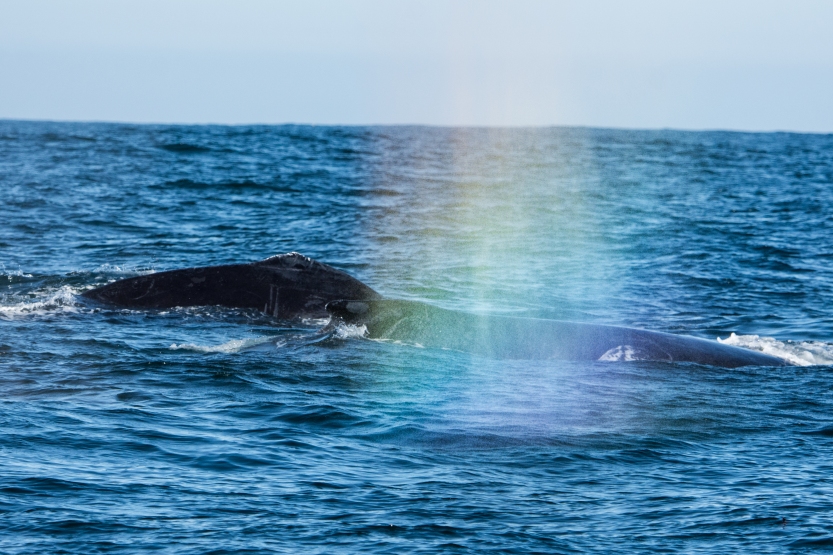
- A Rainbow Blow
Citizen Science
Each Humpback whale has a unique tail, with the underside being shaped or marked in such a way as to give it it’s own ‘fingerprint’. Images of these tails are now being used to track whale movements around the world in a citizen science project.
I, and many other whale enthusiasts submit our photographs to happywhale.com where the individual whale is identified and its movements recorded. I can then subscribe to follow my whale’s movements.
One of my whales from this trip is known as Duck Face (aka Beaker) due to the damaged tail being shaped like a duck bill.

I used to think that whales swim all the oceans of the world and an individual whale was free to circumnavigate the globe for just for fun and freedom. Duck Face has been photographed and recorded 20 times between 2006 and 2020 and every sighting was on the relatively short stretch of coast between Baja California in Mexico and Monterey Bay. Another whale, Crafty, made it from Monterey as far south as El Slavador but still sticking to the same coastline. A third whale that I photographed and follow is Angel Wing and she has been seen over 100 times in the last eleven years, but every sighting has been in Monterey Bay. It appears that she is a resident.
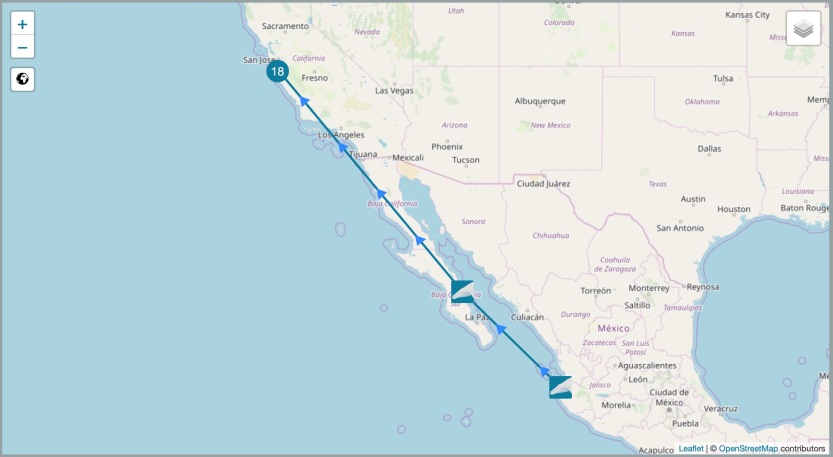

Who to go Whale Watching with
If you’re going to go whale watching then you need to find the tour operator for you. Here are some of the experiences that I have had:
Moss Landing
- Blue Ocean Whale Watch – I’ve been out with Captain Kate Cummings on the 60 foot High Spirits vessel a few times. It is a nice boat with a capacity of 47 passengers plus crew, and a whale geek captain. The bonus with this boat is that the High Spirits has a top deck which gives a unique perspective to the budding photographer. My best ever day of whale watching was with Kate and her team.
- Sanctuary Cruises – A small, friendly 43 foot 39 passenger plus crew capacity boat. Good access around the boat with an intimate feel. I had my second best day on the water with Sanctuary.
Monterey
- Discovery Whale Watch – Based on Fisherman’s Wharf in Monterey, Discovery is well organised with large boats. My last trip was on Pacifica; a 50 foot boat for 47 passengers and crew. Discovery get bonus points for providing the kids with a check-list and a small gift for completing the check-list. More bonus points for having a great naturalist (Eric) who freely shares a lot of information about ALL the life of the Bay and not just the marine mammals.
- Monterey Bay Whale Watching – My experience has been good, even though it is a larger vessel with more people on board. This is the boat that I have seen the most dolphins with. I know they had good luck with Blue Whales in 2019 although I haven’t personally seen Blues in the Bay.
All of these trips are available at less the $60 per adult. A whale watching trip combined with a walk around the harbor area represents better value than a ticket for the phenomenal Monterey Bay Aquarium in my humble opinion. There are trips available for groups of 6 on very small boats. This would be my preference, but it is also much (4x) more expensive. Also, I wouldn’t want to be on the small boat in rough weather.
What to Wear
- Layers. It can get cold on the Bay even in the warmer months. Showers and fog can drift through without warning. I wear jeans and a pair of good walking shoes and layer up on the top half. I’ll often put 4 layers on with the top one being a waterproof windcheater. Take a hat and sunglasses, too!
What to Take
- Sun lotion due to the reflections
- drinking water and a snack
- Don’t forget medication if you suffer with motion sickness
- Photography equipment: many people are happy just to experience whales and a few photos or video on the phone are enough. Obviously that isn’t how I work. You can get some terrific photos with a decent DSLR fitted with any lens between 200mm to 400mm. I have found my Nikon 200mm to 500mm to be too big for the job when the whales are close, so I now use a Nikon 80mm to 400mm zoom with a Nikon D7200 DSLR.
Staying in Monterey
- Where to stay: Hotel Abrego – there are plenty of other places, but I keep coming back here. It never disappoints.
- Where for tea and coffee: Water + Leaves – excellent tea, decent coffee and great pastries on Fisherman’s Wharf in Monterey. You can watch Harbor seals and sea otters from the window if you’re lucky.
- Where for great Coffee: ACME Coffee Roasting Co. – If you’re a coffee hound like me, this is the place to grab a to-go pre-whale watching coffee and a delicious donut. It really is excellent! It opens at 6.30am but it is closed on Sunday.
- Where to celebrate with a great meal: Scales Seafood & Steaks – I’ve had a couple of delicious meals in here after a good morning of whales
Join the conversation below. What whale watching advice would you add and where else would you recommend for certain whales sightings? 👇👇
Like the article? Tweet it, Facebook it or share on your other social media site. It makes the hard work worth it. If you enjoyed this post, take a look at the rest of my work and follow Incidental Naturalist.
Categories: USA
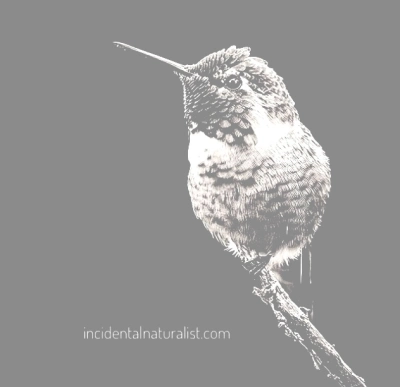


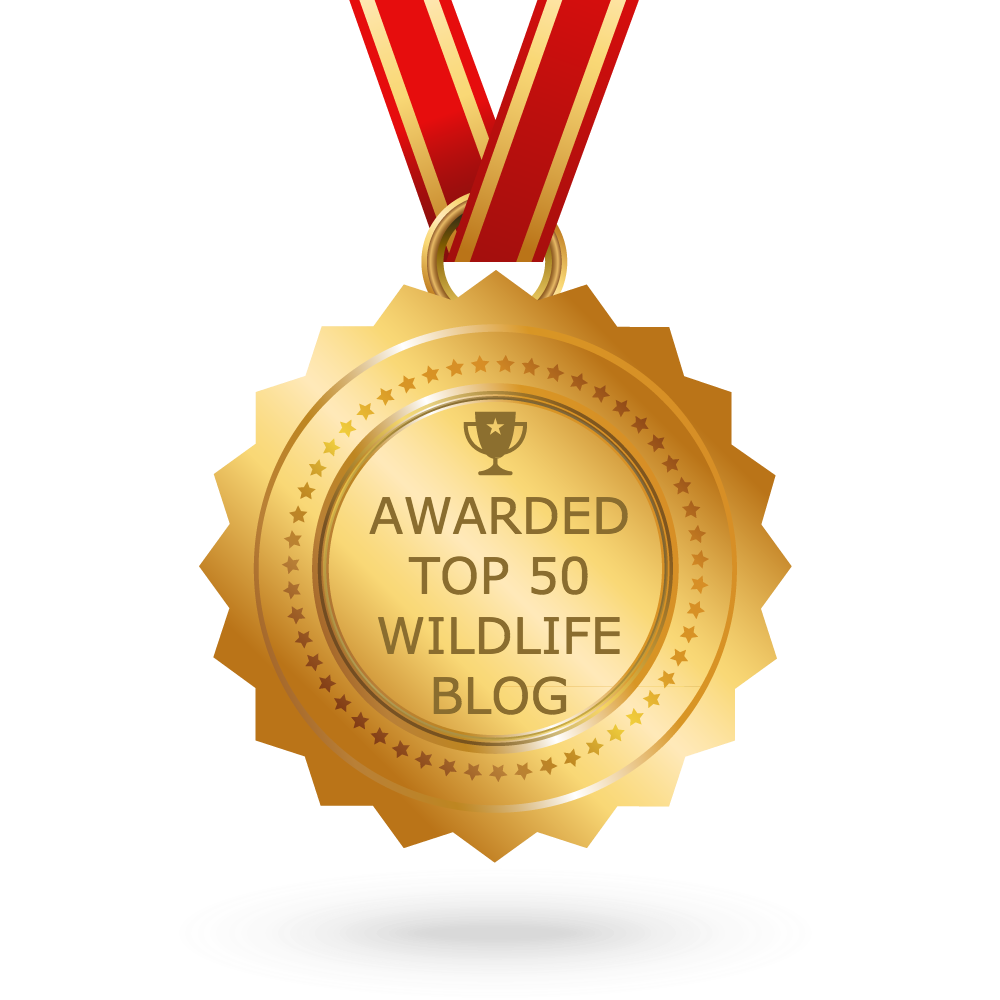

What a wonderful experience — and great photos!
LikeLiked by 2 people
Thank you, Kate! 🙏 Monterey Bay is an extraordinary place. I have had so many wonderful wildlife experiences there. I hope you get to take your little ones there some day.
LikeLike
Nice timing! Phill and I are headed out on a boat on Friday. We’ve been watching the migration from Dover Heights over the last few weeks so looking forward to seeing them much closer. Also hoping the weather is nice! Thanks again for sharing your tales. I hope we come back with some good stories – and images too. Take care, Em
Sent from Yahoo Mail for iPhone
LikeLiked by 2 people
Hi Em! Wow, fantastic that you’re getting out on the water. Hope you get a calm day and maybe some flying whale action. I’ve seen a few images from Sydney recently of great jumping humpbacks🤞🏻I look forward to seeing the photos.
LikeLike
Great post 😁
LikeLiked by 2 people
Thank you! 😊
LikeLike
Amazing photos! I find it so difficult to predict where the whales will appear which makes it difficult to get close-up. But you seem to be doing well!
LikeLiked by 2 people
Thank you! 🙏 On days when the whales are feeding on the surface the birds and sea lions will tell us roughly where the whales will appear. The excitement is the exact position and the moment of appearance.
LikeLiked by 1 person
Reblogged this on Wolf's Birding and Bonsai Blog.
LikeLiked by 2 people
Colorful
LikeLike
Looks spectacular – such intimate views based on your telling images. Love the shot with the rainbow blow and I appreciated the Moby Dick ref. Heard you can get pretty close to sea otters out that way too.
LikeLiked by 2 people
Thanks for the kind words of appreciation. They mean a lot! Haha, it’s like you read my mind. I have a similar post to publish in the future that takes a look at what is probably the best place in the world to get up close to sea otters. I have a few spots that always brings them close to me.
LikeLike
Will look forward to that then. Is it a place you can explore fairly independently then? I was looking at trips for this August but obviously plans for this year have been somewhat scuppered.
LikeLiked by 2 people
Yes, so long as you have a car it is really easy to find a few wildlife hotspots along the coast. There is a wonderful stretch for of coast that takes in whales, sea lions, Grey seals, Elephant seals, a Monarch butterfly roost, sea otters, the very elusive and critically endangered California condor and much more. I’ve blogged about a few of those creatures and am happy to share the places I’ve seen creatures.
LikeLiked by 1 person
Would you? That’s really kind and I would certainly take advantage if you can afford the time to share. Cheers David.
LikeLike
Thanks Dave, awesome post, well said and great photos!
I really liked it as I particularly love this time of year in Sydney with it being Whale migration season and just love being able to observe these amazing animals fairly close up.
LikeLiked by 2 people
Thanks Phill! Much appreciated. It is a great time of year to be in Sydney. You’re very fortunate to see whales so close to shore.
LikeLike
What a great day you had in this magical place! We were visiting the Monterey Bay Aquarium in 2016, while meeting with our daughter, a marine biologist specializing in giant and colossal squid, who was returning from a research voyage out into the submarine canyons, and took advantage of the opportunity to undertake a cruise out from the Elkhorn Slough. Here’s a brief post I published soon afterward: https://krikitarts.wordpress.com/2014/12/12/tails-we-win/. Love your shot with the sooty shearwater; they’re called muttonbirds here in New Zealand.
LikeLiked by 2 people
I love this comment, thanks! I have visited the aquarium at Monterey a couple of times. My son loves it! He now owns a plush Giant squid 🦑 Who knew they would make those? He loves it! Thanks, I got quite lucky that the muttonbird flew over the tail at the right moment. I’ll check out your article now. My first ever whale watching trip was at kaikoura in New Zealand. It was mind blowing and remains my only Sperm whale encounter.
LikeLiked by 1 person
What a thrilling experience well-told. Great shots as well. Thanks!
LikeLiked by 2 people
Thank you! Very kind and very encouraging 🙏
LikeLike
I was almost there with you! I wish I had been! I could feel the salt air and your excitement. You brought it to life so well with your words, and your photos are stunning. Thanks for the adventure! Maybe one day I’ll get to do it IRL.
Alison
LikeLiked by 2 people
Thank you so much for your words, Alison. Comments like this make the hard work of writing and constructing a blog post worth it. I do hope you get to have a Monterey Bay experience.
LikeLiked by 1 person
Nice to see your awesome photos and magically descriptive writing, Dave. Whales deserve our utmost respect. Monterey Bay really is a gem. I was out there last year, but didn’t get out on the ocean. A number of years ago we went kayaking on Elkhorn Slough and had some wonderful close encounters with sea mammals.
LikeLiked by 2 people
Thank you, Eilene! Very kind words and so encouraging. The Monterey Bay coastline is awesome even if you don’t get out on the ocean. So much wildlife and so much beauty. I always visit the Elkhorn Slough area when I’m there. It is fizzing with wildlife!
LikeLiked by 1 person
Your photos are incredible, but what I loved about this post was how you chronicled your own excitement and passion and the visceral experience of seeing such magnificent creatures up close. Thank you!
LikeLiked by 2 people
Thank you so much for the kind words. I’m thrilled that you could feel the excitement of the experience. Every encounter with a whale is special moment for me.
LikeLiked by 1 person
My husband and I used to go whale watching off the Cape of Massachusetts every summer. We loved it so much and your blog really brought that back to me. Though we never had anything as thrilling as your experience.
LikeLiked by 1 person
I haven’t been whale watching off the Atlantic coast yet, but there were a lot of Humpbacks off of Manhattan last season. I have been whale watching many times. Some days I see a lot of whales, some days not so many, but it is a very special day when you get to look into a whale eye. A day like that is to be treasured! I hope you get out to spend time with whales again soon.
LikeLiked by 1 person
Thanks, David! So do I!
LikeLiked by 1 person
Thanks for the post! Now I know where to go to see whales… well, at least until the coronavirus pandemic is over…
LikeLiked by 2 people
Great work as usual David! If you head for the Monarchs in Pacific Grove, don’t miss PG Juice & Java or Holly’s Lighthouse Cafe, both downtown Pacific Grove. Land lubbers can see the harbor seals on the rocks in Perkins Park near Lover’s Point.
LikeLiked by 2 people
Thanks for the kind words and for the tips, Ann. I have been to see the Pacific Grove Monarchs a couple of times (see previous post) but I’ll keep your recommendations in mind for next time.
LikeLike
“) Thanks for those sharp photo captures, companies listed, and always your good facts, David!
LikeLiked by 2 people
Thank you, Lara! Your kind words are always appreciated.
LikeLiked by 2 people
This is beautifully written ❤️
I have a wildlife blog… Do follow it and don’t forget to like share and comment 😊
LikeLiked by 2 people
These photos are amazing. I’ve always wanted to see them in nature, but still have not. Maybe I’ll get the chance when we go to CA next year. Thanks for all the detailed information.
LikeLiked by 2 people
Thanks for the kind words! I hope you get a chance to see whales in California. There is an incredible amount of wildlife along the coast between San Francisco and Santa Barbara. Definitely a place to go for some awesome encounters.
LikeLiked by 1 person
It really takes a lot of effort to write such an amazing piece of writing with such brilliant creativity and information
Kudos keep writing more
LikeLiked by 1 person
Thanks for the kind words! Much appreciated, and it makes all the effort worthwhile.
LikeLike
My God!,now I want to go Whale watching.
I’ve never really thought about going Whale watching. But after reading this post, it’s in my to do list.
LikeLiked by 1 person
It is a fantastic experience. Any time I travel near water I look for whales near by 😊
LikeLike